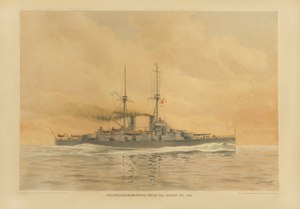Sverige-class coastal defence ship

A 1912 depiction of Sverige
|
|
| Class overview | |
|---|---|
| Name: | Sverige class |
| Builders: |
|
| Operators: |
|
| Preceded by: | Oscar II |
| Built: | 1912–1922 |
| In commission: | 1917–1957 |
| Completed: | 3 |
| Scrapped: | 3 |
| General characteristics | |
| Type: | Coastal defence ship |
| Displacement: |
|
| Length: |
|
| Beam: | 18.6 m (61 ft) |
| Draught: | 6.2 m (20 ft) |
| Propulsion: |
|
| Speed: |
|
| Complement: |
|
| Armament: |
|
| Armour: |
|
The Sverige-class coastal defence ships were a class of coastal defence ships that, at the time of introduction, were the largest ships to serve in the Swedish Navy. Their design was completely new and was influenced by the ships of the time. Their armament consisted of four 283 mm (11.1 in)/45 cal. Bofors guns in two turrets and eight 152 mm (6.0 in) Bofors guns in one double and six single turrets. During the Second World War they were the backbone of the Swedish Navy.
All three ships looked similar until reconstruction. Gustav V had funnels trunked into one and the upper works modified heavily. Sverige had the fore funnel trunked back away from the superstructure which was modified, and kept the second funnel, making the ships very different in appearance between the main turrets. Gustav V also har her forward superfiring 2 x 152 mm tower removed, and replaced with a platform for gyro-stabilized AA artillery ( 4 x 40 mm bofors) while Sverige and Drottning Victoria had their midship single 1 x 152 mm towers removed and replaced with gyro-stabilized AA platforms (Bofors 40 mm double mountings)
Sverige in 1929
Drottning Victoria after 1931
Gustav V after 1930
Sverige after 1931
Three of these ships were built:
A fourth ship was considered but not built due to economic difficulties.
The ships were modernised in the 1930s with oil-fired boilers replacing the old coal-fired boilers, removal of underwater torpedo equipment, new anti-aircraft guns and fire control equipment.
The Sverige-class ships differed in several ways from the classical coastal defence ship; at first by heavier armament as well as better speed and armour, but still small enough to operate and hide in the archipelagos and shallow waters . But the main difference was to be noted in their tactical doctrine and operations. Unlike other coastal defence ships, the Sverige class formed the core of a traditional open-sea battle group (Kustflottan), operating with cruisers, destroyers, torpedo boats and air reconnaissance like traditional battleship tactics of the time. This "mini battle group" had no intention to challenge the superpowers in blue sea battles but to operate as defensive shield to aggression challenging Swedish interests and territory. Based on the doctrine that you need a battle group to challenge a battle group. "kustflottan" presented a considerable obstacle to anything smaller than a battleship or battlecruiser, but in a tactical situation where traditional battelships would have limited operational space exposing them to submarines, fast torpedo crafts and minefields. It has been suggested that the Sverige-class ships were one reason why Germany did not invade Sweden during World War II. This speculation appeared in Warship Magazine 1992 Edition, in the article "The Sverige Class Coastal Defence Ships", by Daniel G Harris. The claim was supported in the postwar publication of German tactical orders, when tactical scenarios regarding attacking Sweden was published. Pointing out the problems of maintaining an army in Sweden without sea superiority, and underlining lack of available suitable units to challenge the Swedish navy (“Stations for battle”, Insulander/Olsson, 2001)
...
Wikipedia
